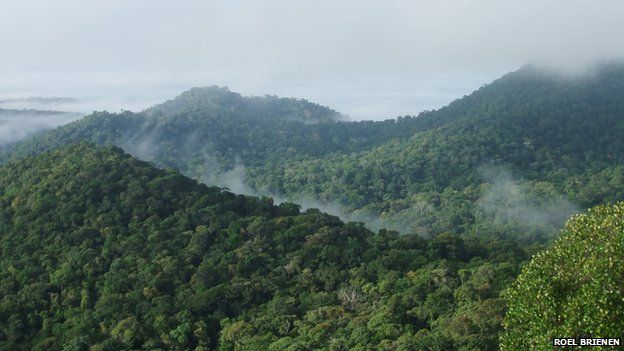Amazon: 1% of tree species store 50% of region's carbon
- Published

About 1% of all the tree species in the Amazon account for half of the carbon locked in the vast South American rainforest, a study has estimated.
Although the region is home to an estimated 16,000 tree species, researchers found that just 182 species dominated the carbon storage process.
Amazonia is vital to the Earth's carbon cycle, storing more of the element than any other terrestrial ecosystem.
The findings appear in the journal Nature Communications.
"Considering that the Amazon is massively important for the global carbon cycle and stores so much of the planet's biomass, finding out just how that carbon is stored and produced is very important if we want to understand what might happen in the future in different environmental conditions," explained co-author Sophie Fauset from the University of Leeds, UK.
The tropical forest covers an estimated 5.3 million sq km and holds 17% of the global terrestrial vegetation carbon stock.
The findings build on a study published in Science in October 2013 that found that despite being home to an estimated 390 billion trees - made up by 16,000 species - just 227 "hyperdominant" species accounted for half of Amazonia's total trees.
Dr Fauset observed: "If you then take abundance into account and then analyse the data again, then maximum size is very important as well. Trees that are able to reach a large size contribute more to the carbon cycle."
As trees grow larger, they develop more biomass, which contains carbon. So the larger the tree, the greater quantity of carbon locked within its wood. As trees are long-lived organisms, this means the carbon is removed from the atmosphere for decades, if not centuries.
However, Dr Fauset cautioned against the idea of focusing attention on the 182 species and embarking on a vast planting programme to lock more carbon away from the atmosphere, where it contributes to global warming.
"While we have shown that there are a small number of species having a disproportionate influence on the carbon cycle, that is only what we have been able to measure right now," she told BBC News.
"Given the amount of changes that are occurring in tropical regions, such as with the climate and with land-use changes, in the future there might be different species that become more important."
A good example is the Brazil nut tree (Bertholletia excelsa), which can reach heights in excess of 48m (160ft). It is known to thrive best in dense, undisturbed rainforests.
A study in 2010 examining the natural dispersal of Brazil nuts suggested their intensive harvesting could threaten future regeneration of the trees.
Researchers found that large rodents - such as agoutis - quickly ate the nuts, rather than caching them, when supplies were scarce. When supplies were plentiful, almost twice as many nuts were buried, increasing the chance of successful germination.
This means that the species may not play such a dominant role in the carbon cycle in the future.
"Therefore, it is important that you maintain a bio-diverse forest that has a wide range of species with a wide range of life histories and strategies that will be able to deal differently with changes to the environmental conditions, " Dr Faucet added.
"In the future, it might be different species that are more important for the carbon cycle than what we have measured right now."
In a previous study, Dr Faucet and a team of fellow scientists found that the carbon storage capacity of protected forests in West Africa had increased despite the region suffering a 40-year drought.
The team suggested the increase in the forests' carbon-storing biomass was the result of a shift in species composition.
As the drought period stretched over decades, it allowed the species that could survive under those conditions to be favoured.
Unaccounted emissions
The complexity of the global carbon cycle was highlighted in a separate study, also published on Tuesday.
Researchers suggested that global carbon emissions from forests could have been underestimated because calculations have not fully accounted for the dead wood from logging.
A study carried out in Borneo, published in Environmental Research Letters, found that dead wood could account for up to 64% of biomass. In untouched forests, dead wood made up less than 20% of the above-ground biomass.
Lead author Dr Marion Pfeifer, from Imperial College London, observed: "I was surprised by how much of the biomass dead wood accounted for in badly logged forests.
"That such logged forests are not properly accounted for in carbon calculations is a significant factor.
"It means that a large proportion of forests worldwide are less of a sink and more of a source, especially immediately following logging, as carbon dioxide is released from the dead wood during decomposition."
Estimates suggest that forestry, agriculture and land-use changes account for almost a quarter of greenhouse gas emissions from human activities. Only the energy sector emits more.
- Published17 October 2013
- Published26 August 2012
- Published6 January 2012
- Published11 May 2010
- Published26 July 2012
- Published18 February 2011